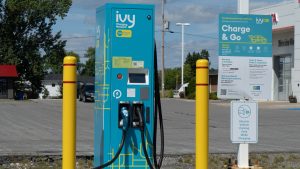Devin Arthur, Director of Government Relations at the Electric Vehicle Society, outlines the growing significance of Ontario’s battery metals.
With vast deposits of minerals including cobalt, graphite, lithium and nickel, Canada holds great potential in the development of green technology. Due to the rapidly increasing demand for metals used in batteries for electric vehicles (EVs) and in sustainable energy technologies, supply chains are under significant pressure and improved technologies and procedures are required to manage and sustain this demand.
The province of Ontario, with an abundance of rich mineral resources, has a strong awareness of this demand and is working on innovative and efficient ways to contribute on the global stage. By focusing on the collaboration between the mining and battery production industries, the province intends to create a more efficient electric vehicle battery supply chain.
One organisation that recognises the value of battery metals production in Canada is the Electric Vehicle (EV) Society. The not-for-profit organisation advocates for the value of electric vehicles and aims to make Canada’s transition to green energy easier. Through its work, the EV Society is ensuring Ontario, and Canada in general, recognises its value in EV production.
The Innovation Platform spoke with Devin Arthur, Director of Government Relations for the EV Society, to discuss Ontario’s significance in battery metals production, and what the province is doing to manage global demand.
What is the current outlook for battery metals production in Ontario? Is it positioned to meet the rising demand?
Most of the world has set an ambitious target of 100% electric personal vehicle sales to be achieved in the 2030s, meaning the race is on to meet the staggering demand in critical minerals.
A recent study1 has shown that, due to our current nickel output worldwide, the future demand for electric vehicle battery production may only be met by 50%.
However, with new mines and processing coming online, this should even itself out by the late 2030s.
What does this mean for Ontario’s battery metals industry? It means that every single gram of nickel coming out of the ground could potentially be sold for batteries, which would be significant for both the mining industry and Ontario’s economy.
With all the potential deposits in the Ring of Fire, Sudbury, Timmins and other locations throughout the province, this could mean decades of increased economic growth and new jobs. It could also spur more advanced technology, research and development (R&D), mining supply and services – all excellent news for our economy.
What electric vehicle developments are happening within the province and how is this impacting demand?
Ontario’s battery metals and mining industry are substantial and there are many R&D projects centred around how the industry can support EV growth and battery manufacturing. Technology can bleed across industries, so the Ontario Centre for Innovation created an organisation combining talent across different industries to create a singular organisation that can streamline research, development and prototyping.
The Ontario Vehicle Innovation Network (OVIN) is an initiative of the Government of Ontario, led by the Ontario Centre of Innovation (OCI), designed to reinforce Ontario’s position as a North American leader in advanced automotive technology and smart mobility solutions such as connected vehicles, autonomous vehicles and electric and low-carbon vehicle technologies. Through resources such as research and development (R&D) support, talent and skills development, technology acceleration, business and technical supports, and demonstration grounds, OVIN provides a competitive advantage to Ontario-made automotive and mobility technology.

IVY charging station in Ontario, Canada
Recently, OVIN has expanded to include northern sites in the Northern Research Technology Demonstration Site (NRTDS), named Core5, ran out of the NORCAT offices in Sudbury. This network includes partners like Cambrian College, Cannadore College, and the Timmins Economic Development Corporation. These partnerships are creating many ancillary industries and projects have been developed to help foster EV growth in Ontario.
One recent project centred around vehicle-to-everything (V2X), and how 5G can enable new and innovative ways to decrease border crossing times between the US and Canada.
The mining industry is constantly innovating. Recently, Frontier Lithium announced Canada’s first lithium hydroxide demonstration plant construction just outside of Sudbury, which will help support the domestic battery electric vehicle (BEV) supply chain. The plant will provide first-hand experience in the processing of lithium ore into the key ingredient required in EV battery production.
In the future, the lessons learned will be integrated into a fully-fledged processing plant, capable of producing higher volumes to export to battery manufacturers across North America.
Aside from technological innovation and mining, there are other, more direct EV developments happening to foster demand. The IVY Charging network just expanded to all OnRoute locations across the province, drastically increasing the amount of EV charging across major travel corridors across the southern portion of the province, in what’s known as the ‘Windsor-Montreal corridor.’ This expansion indirectly increases EV demand by solidifying support for electric fuelling and giving consumers the confidence to charge when travelling throughout the province.
What do you think needs to change in order to accelerate the development of Ontario’s battery metals to meet the increasing demand for EV batteries?
One of the issues holding back critical mineral projects is the availability of capital to get projects up and running. Mining projects are very capital intensive, and companies with a large global footprint may not be able to justify such investment to expand in a comparatively small market. Smaller companies, on the other hand, like junior miners, are unable to raise the necessary funding to even start projects.
Both the federal and provincial governments have laid out their critical mineral strategies, with billions of dollars earmarked for expanding operations across Canada and Ontario. As of yet though, this money has not been flowing quick enough. This is compounded by the fact that mining projects can typically take ten or more years to go from design to operational, due to permitting, environmental impact, and other regulatory requirements. Timing needs to be at least halved to sustain the amount of industry growth necessary to support the battery ecosystem.
Another way jurisdictions can attract large-scale industrial operations, like mineral processing plants and automotive factories, is to lay the groundwork for these locations. As demonstrated by previous deals, such as Volkswagen in St Thomas, Ontario, having ‘shovel-ready’ industrial land is key to attracting and encouraging companies to build in locations they may not have otherwise considered. This means the site is serviced with municipal water, sewage, power, and other services so that companies coming in can start building right away, an increasingly important factor given the timelines automakers are facing to transition to EV.
A recent example of this is in Greater Sudbury, where Mayor Paul Lefebvre recently announced that parcels of industrial land were to be shovel-ready in order to attract potential mineral processing plants to the city – one of the key messages at the recent BEV in Depth: Mines to Mobility conference.
These issues can be solved. Critical mineral strategies have billions of dollars in capital to be distributed, which can help accelerate projects to completion.
Recent announcements by both Ontario and federal governments have also signalled a review of the regulatory hurdles required to permit and approve new mining projects, and could theoretically fast-track projects that contribute to critical mineral extraction for clean-tech and EV supply chain use.
What is Ontario’s potential to contribute to the global battery metals and EV supply chain?
Ontario has the potential to become a world leader not only in mineral extraction and processing, but also in advanced manufacturing, research and development and other ancillary industries related to automotive and mining.

Thanks to the countless mineral deposits in northern Ontario providing critical elements needed for clean technology, the factories and skilled workforce in southern Ontario that specialise in vehicle parts and accessory manufacturing, Ontario has the potential to become its own single-sourced jurisdiction for the entire EV supply chain.
We have all the right ingredients to take advantage of this generational opportunity. Now, we must make the right decisions and invest in the right places to ensure Ontario can become the number one investment opportunity in the world.
References
Please note, this article will also appear in the fifteenth edition of our quarterly publication.









